Foodie Heaven
It's amazing what you can concoct with a little rummaging around you kitchen cupboards. You won't find the recipes in Rachel, Jamie or Delia's cookbooks but throw in a handful of rice and pasta, a dash of bright paint, a couple of jam jars or bits of string and you have a recipe for successful learning.
Rainbow Rice – Ellie Boyd
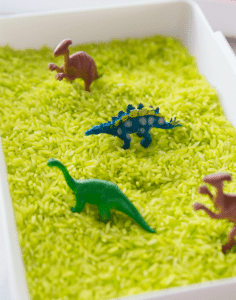 Enjoy a creative session using brightly coloured paint to colour rice and create an easy sensory play area or rainbow decoration.
Enjoy a creative session using brightly coloured paint to colour rice and create an easy sensory play area or rainbow decoration.
Learning intentions
Focus on the use of mathematical language (e.g. full, empty, big, small, more, less, heavy and light).
Activity
1. You can colour rice with any sort of paint! Just squeeze ordinary poster paint onto plain rice and let the children mix it in until the rice changes colour. They will really enjoy the mixing!
2. Let the rice dry overnight and then place it into any large container or tray. This could be an old plastic box or a shoebox, etc.
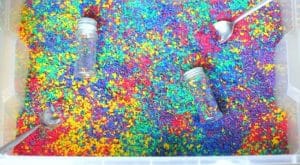 3. Let the children play with it, filling different containers, tubes and pots with spoons, spades, etc.
3. Let the children play with it, filling different containers, tubes and pots with spoons, spades, etc.
4. You could also use it as a backdrop for imaginative play (e.g. blue rice for sea, green for grass, etc) and add toys.
5. If you want a lasting legacy, get them to fill an empty jam jar with a rainbow of layers of different coloured rice – a must for all to see!
Smartie Challenge – Heather McKee
Everyone loves Smarties! But can you beat the Smartie challenge? Smarties are so bright and colourful they simply invite you to make patterns.
Learning Intention
Create pattern
Continue a pattern
Activity
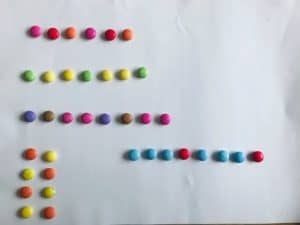 1. Empty a packet of Smarties into a bowl
1. Empty a packet of Smarties into a bowl
2 Ask your child to challenge you to create a pattern by using the names of the colours, for example: red, yellow, red, yellow, red, yellow.
3. You then create the pattern suggested by your child.
4. Now that you have demonstrated how to play, it’s your turn to challenge your child in the same way. Remember to keep it simple to begin with e.g. blue, green, blue, green, blue, green.
5. Let your child lead the simplicity or difficulty of the patterns. No doubt they will want to challenge you to a difficult one and the options are endless!
Eat and enjoy the Smarties!
Pasta Bling! – Ellie Boyd
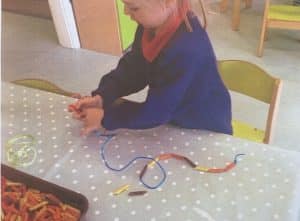 Have great fun making some colourful bling with this great pasta activity.
Have great fun making some colourful bling with this great pasta activity.
Learning outcomes
Focus on development of fine motor skills using threading and early understanding of pattern through the introduction of colour patterns.
Activity
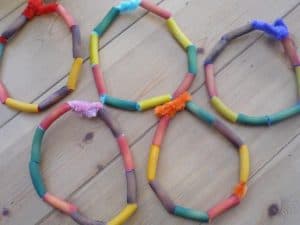 1. Pasta can be coloured with paint too. Put pasta into a sandwich bag along with some paint. If you have PVA glue, add a squeeze of it too (but not essential). Using different colours is good for creating different patterns.
1. Pasta can be coloured with paint too. Put pasta into a sandwich bag along with some paint. If you have PVA glue, add a squeeze of it too (but not essential). Using different colours is good for creating different patterns.
2. Get the children to thread the pasta onto a string or thread to make lovely necklaces and bracelets! Pipe cleaners can be easier for smaller children as they aren’t as flexible.
Let’s Measure – Colleen Megarry
Enjoy this fun measuring capacity activity where children could have hours of fun and not realise that they are learning at the same time.
Learning Intention
Compare containers which have varied capacities and differ in shape. Use mathematical language such as full, half full, empty.
Resources
Tray, basin, empty containers, spoon pasta, rice, lentils or water.
Activity
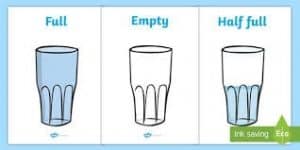 1. Fill the tray or basin with either rice, pasta, lentils or water. Then from around the house add some different sized empty containers.
1. Fill the tray or basin with either rice, pasta, lentils or water. Then from around the house add some different sized empty containers.
2. Allow the child to lead their own play by exploring this activity, so that they will become familiar with the equipment.
3. Encourage the child to pour or spoon rice from one container to the other. This will help them begin to understand how much fits inside a container.
4. Join in with the child at play by showing them what full, half full and empty looks like. Use these mathematical words to give children a better understanding as they play and try them out also.
5. Once the child seems confident, ask them to show you a container that is full, half full or empty while playing naturally alongside them.
6. Remember have fun playing and spending time together.
Baking Activities – Oonagh McLaughlin
Learning Intention
Any of these baking activities will support your child with their fine motor (refined) and gross motor (large movement) skills. They also can practise skills in measuring quantities and will enjoy observing the changes to the mixture when adding different products. And of course the tasting and decorating! You can use this as an opportunity for extending their vocabulary as you talk to them about the stages, getting the child to describe what they are doing, feeling and experiencing.
Activity
1. Pancakes: This mix will make about 15 fluffy American style pancakes. You don’t need to measure anything on scales – instead you can use a tea cup or mug. This mixture can also be used to make muffins rather than pancakes
- 1 cup self raising flour (for the fluffiness), 1 cup of milk and 1 egg (whisked). Mix this altogether in a jug. At this point you could grate in a pear or an apple. It is also really nice to add in blueberries or a tablespoon of chocolate chips and mix together. After the mixing, heat a pan with a knob of butter. Then, when the pan is ,add a ladle of the mix to cook. When you see air bubbles forming on the surface the pancake is ready to be flipped over.
- If you don’t have self raising flour you can make your own by adding baking powder and bicarbonate soda (baking soda). For every 150g (approx 1 cup) of plain flour, add in half a teaspoon of baking powder and half a teaspoon of bicarbonate soda.
- This again could be another chance to experiment – what mix will make the fluffiest pancakes? How will you decide – compare the two? How will you make it a fair test? Can you measure anything?
2. Chocolate Chip Cookies: This will make about 2 baking trays / 30 cookies worth. You could also add in oats and raisins rather than the chocolate!
- 150g salted butter/80g of light brown sugar/80g of white sugar/2 tea spoons vanilla extract/1 large egg/225g of plain flour/half teaspoon of bicarbonate soda (baking soda)/ quarter tea spoon of salt/ 200g chocolate chips or chunks-this can be white, milk or dark chocolate.
- Pre heat oven to 190C. Cover two baking pans with non stick baking parchment. In a bowl, mix the butter, brown sugar and white sugar. Add vanilla extract and an egg. Sift in the flour, bicarbonate soda and salt. Add in the chocolate! After the mixture is combined use a teaspoon to take small scoops of the mixture to the baking tray. Space them well apart. Bake for 8-10 minutes!
- If your child enjoys making certain recipes, they could use these to create cooking cards which could be shared amongst friends via a text messaging app. You and your child could design simple recipe cards containing a list of ingredients, a series of instructions and then an illustration. Give their recipe a title and share with friends.
Digestive Teddy Bears – Nicola Andrews
Experiment by mixing colours into icing to decorate teddy bear biscuits.
Learning Intentions
To develop fine motor skills; investigate mixing colours; and use mathematical language.
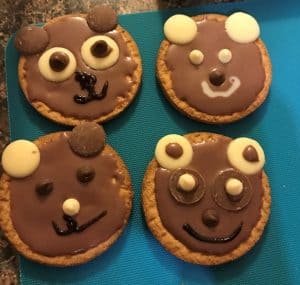 Activity
Activity
1. Resources: biscuits, icing sugar, food colouring (red, blue, yellow), chocolate buttons, chocolate drops, pipette dropper, bowl and spoons.
2. Children can make their own icing using the droppers to add the water. They can discuss how much water is needed.
3. They can then add the food colouring to make the required colour for their bear.
4. This will give the children an opportunity to see what colours are made when the red, blue and yellow are added together.
5. Once the desired colour has been made, the children can decorate their biscuit to look like a teddy bear.
